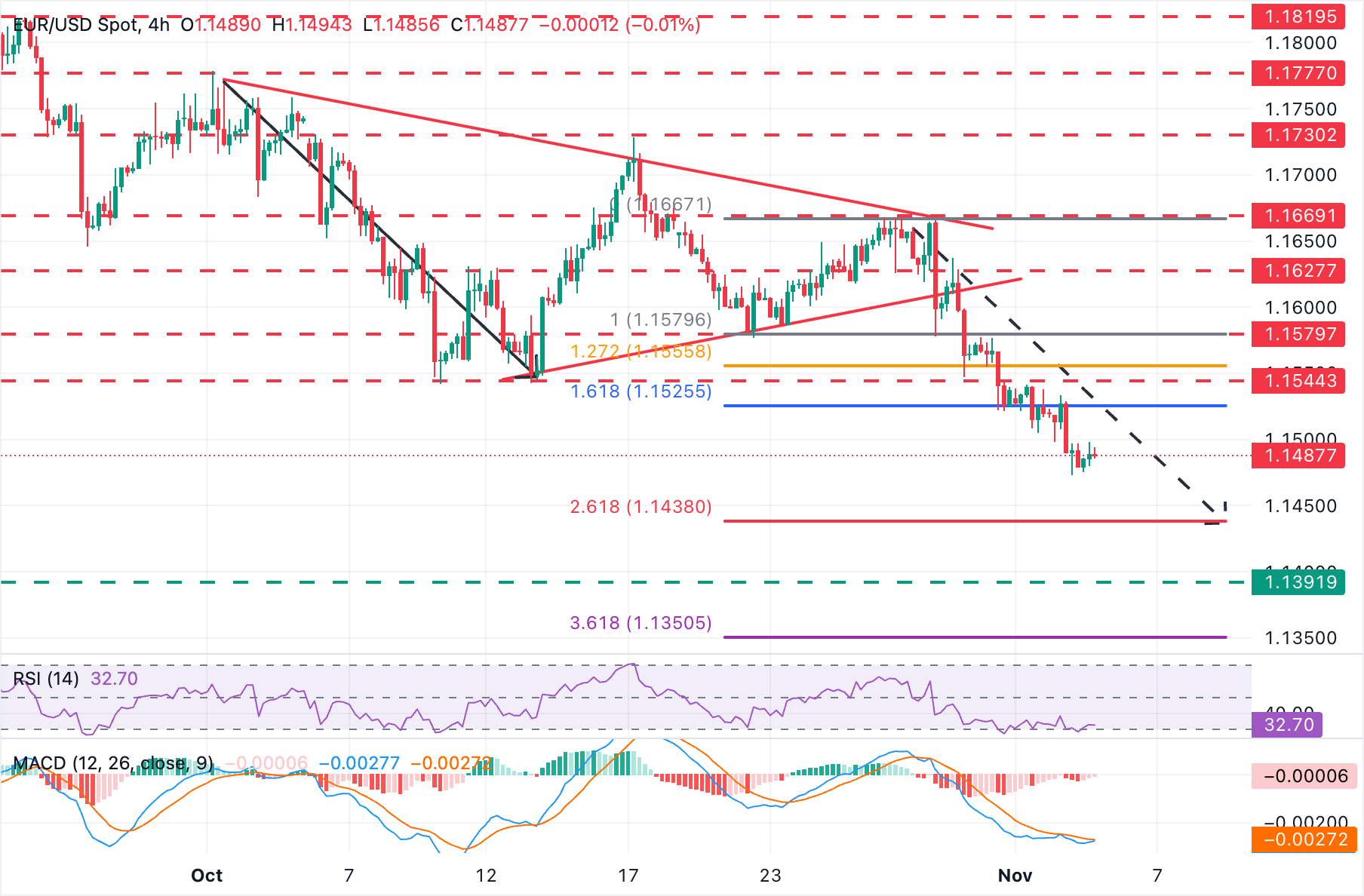Created
: 2025.11.06














![]() 2025.11.06 17:11
2025.11.06 17:11
EUR/USD posts moderate gains for the second consecutive day on Thursday, trading at 1.1505 at the time of writing, up from the three-month lows at 1.1468 hit earlier this week. Equity markets bounced up as concerns about the US tech sector eased, and better-than-expected European corporate earnings have eased fears about the region's economic outlook.
The Euro's recovery, however, remains limited as the US Dollar remains firm after the publication of strong US macroeconomic data. ADP figures for October beat expectations, and the services sector's activity accelerated at a faster pace than expected, with new orders showing a significant increase. These figures cast further doubts on a Federal Reserve (Fed) interest-rate cut in December and are likely to limit the US Dollar's downside attempts.
On Thursday's economic calendar, some European Central Bank speakers are scheduled to speak, but the highlight will be the Eurozone Retail Sales release. In the US calendar, a slew of Fed speakers will be observed with interest after the positive surprise from the ADP Employment Report.
The table below shows the percentage change of Euro (EUR) against listed major currencies today. Euro was the strongest against the New Zealand Dollar.
| USD | EUR | GBP | JPY | CAD | AUD | NZD | CHF | |
|---|---|---|---|---|---|---|---|---|
| USD | -0.17% | -0.04% | -0.09% | -0.05% | -0.07% | 0.07% | -0.11% | |
| EUR | 0.17% | 0.13% | 0.07% | 0.12% | 0.10% | 0.24% | 0.06% | |
| GBP | 0.04% | -0.13% | -0.04% | -0.01% | -0.03% | 0.12% | -0.07% | |
| JPY | 0.09% | -0.07% | 0.04% | 0.04% | 0.03% | 0.14% | -0.01% | |
| CAD | 0.05% | -0.12% | 0.00% | -0.04% | -0.01% | 0.10% | -0.06% | |
| AUD | 0.07% | -0.10% | 0.03% | -0.03% | 0.01% | 0.14% | -0.03% | |
| NZD | -0.07% | -0.24% | -0.12% | -0.14% | -0.10% | -0.14% | -0.18% | |
| CHF | 0.11% | -0.06% | 0.07% | 0.00% | 0.06% | 0.03% | 0.18% |
The heat map shows percentage changes of major currencies against each other. The base currency is picked from the left column, while the quote currency is picked from the top row. For example, if you pick the Euro from the left column and move along the horizontal line to the US Dollar, the percentage change displayed in the box will represent EUR (base)/USD (quote).

The EUR/USD pair appreciates further on Thursday, putting some distance from the mid-term lows near 1.1470 hit earlier this week. The 4-hour Moving Average Convergence Divergence (MACD) has crossed above the signal line, and the Relative Strength Index (RSI) is about to test the key 50 area, which endorses the view of a bullish correction after a nearly 1.5% sell-off following the Fed's hawkish shift seen last week.
Bulls, however, are likely to meet significant resistance at a previous support area near 1.1545 (October 14, 30 lows). If this level gives way, the next target is around 1.1580 (October 22, 23 lows) ahead of 1.1635, the October 30 high.
On the downside, immediate support is in the area of 1.1470, which held bears on Tuesday and Wednesday. Further down, the measured target of the broken triangle pattern, which meets the price at the 261.8% Fibonacci retracement of the late October rally, is near 1.1440. August's low comes around 1.1390.
In the world of financial jargon the two widely used terms "risk-on" and "risk off'' refer to the level of risk that investors are willing to stomach during the period referenced. In a "risk-on" market, investors are optimistic about the future and more willing to buy risky assets. In a "risk-off" market investors start to 'play it safe' because they are worried about the future, and therefore buy less risky assets that are more certain of bringing a return, even if it is relatively modest.
Typically, during periods of "risk-on", stock markets will rise, most commodities - except Gold - will also gain in value, since they benefit from a positive growth outlook. The currencies of nations that are heavy commodity exporters strengthen because of increased demand, and Cryptocurrencies rise. In a "risk-off" market, Bonds go up - especially major government Bonds - Gold shines, and safe-haven currencies such as the Japanese Yen, Swiss Franc and US Dollar all benefit.
The Australian Dollar (AUD), the Canadian Dollar (CAD), the New Zealand Dollar (NZD) and minor FX like the Ruble (RUB) and the South African Rand (ZAR), all tend to rise in markets that are "risk-on". This is because the economies of these currencies are heavily reliant on commodity exports for growth, and commodities tend to rise in price during risk-on periods. This is because investors foresee greater demand for raw materials in the future due to heightened economic activity.
The major currencies that tend to rise during periods of "risk-off" are the US Dollar (USD), the Japanese Yen (JPY) and the Swiss Franc (CHF). The US Dollar, because it is the world's reserve currency, and because in times of crisis investors buy US government debt, which is seen as safe because the largest economy in the world is unlikely to default. The Yen, from increased demand for Japanese government bonds, because a high proportion are held by domestic investors who are unlikely to dump them - even in a crisis. The Swiss Franc, because strict Swiss banking laws offer investors enhanced capital protection.
![]()
Created
: 2025.11.06
![]()
Last updated
: 2025.11.06

FXStreet is a forex information website, delivering market analysis and news articles 24/7.
It features a number of articles contributed by well-known analysts, in addition to the ones by its editorial team.
Founded in 2000 by Francesc Riverola, a Spanish economist, it has grown to become a world-renowned information website.
We hope you find this article useful. Any comments or suggestions will be greatly appreciated.
We are also looking for writers with extensive experience in forex and crypto to join us.
please contact us at [email protected].
Disclaimer:
All information and content provided on this website is provided for informational purposes only and is not intended to solicit any investment. Although all efforts are made in order to ensure that the information is correct, no guarantee is provided for the accuracy of any content on this website. Any decision made shall be the responsibility of the investor and Myforex does not take any responsibility whatsoever regarding the use of any information provided herein.
The content provided on this website belongs to Myforex and, where stated, the relevant licensors. All rights are reserved by Myforex and the relevant licensors, and no content of this website, whether in full or in part, shall be copied or displayed elsewhere without the explicit written permission of the relevant copyright holder. If you wish to use any part of the content provided on this website, please ensure that you contact Myforex.
Myforex uses cookies to improve the convenience and functionality of this website. This website may include cookies not only by us but also by third parties (advertisers, log analysts, etc.) for the purpose of tracking the activities of users. Cookie policy